Which Of The Following Species Is Best Described By Drawing Resonance Structures?
Affiliate 7. Chemical Bonding and Molecular Geometry
seven.4 Formal Charges and Resonance
Learning Objectives
Past the end of this department, you will exist able to:
- Compute formal charges for atoms in any Lewis structure
- Utilize formal charges to identify the nearly reasonable Lewis structure for a given molecule
- Explain the concept of resonance and depict Lewis structures representing resonance forms for a given molecule
In the previous section, we discussed how to write Lewis structures for molecules and polyatomic ions. As we accept seen, however, in some cases, there is seemingly more than 1 valid structure for a molecule. We can employ the concept of formal charges to assistance us predict the near appropriate Lewis construction when more than 1 is reasonable.
Calculating Formal Charge
The formal accuse of an atom in a molecule is the hypothetical charge the atom would accept if we could redistribute the electrons in the bonds evenly betwixt the atoms. Another mode of saying this is that formal charge results when we have the number of valence electrons of a neutral cantlet, decrease the nonbonding electrons, and and then subtract the number of bonds continued to that atom in the Lewis construction.
Thus, we calculate formal charge every bit follows:
[latex]\text{formal charge} = \# \;\text{valence shell electrons (free atom)} \; - \;\# \;\text{alone pair electrons}\; - \frac{one}{two} \# \;\text{bonding electrons}[/latex]
We can double-check formal charge calculations past determining the sum of the formal charges for the whole structure. The sum of the formal charges of all atoms in a molecule must exist zero; the sum of the formal charges in an ion should equal the charge of the ion.
We must recall that the formal charge calculated for an cantlet is not the bodily charge of the atom in the molecule. Formal charge is merely a useful accounting procedure; information technology does not indicate the presence of bodily charges.
Example 1
Computing Formal Accuse from Lewis Structures
Assign formal charges to each atom in the interhalogen ion ICliv −.
Solution
- Nosotros split up the bonding electron pairs as for all I–Cl bonds:
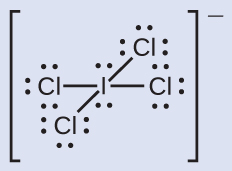
- We assign lone pairs of electrons to their atoms. Each Cl atom now has seven electrons assigned to it, and the I cantlet has eight.
- Subtract this number from the number of valence electrons for the neutral atom: I: 7 – 8 = –1Cl: 7 – 7 = 0The sum of the formal charges of all the atoms equals –1, which is identical to the accuse of the ion (–1).
Check Your Learning
Summate the formal charge for each atom in the carbon monoxide molecule:

Example ii
Calculating Formal Charge from Lewis Structures
Assign formal charges to each atom in the interhalogen molecule BrClthree.
Solution
- Assign one of the electrons in each Br–Cl bond to the Br atom and ane to the Cl atom in that bail:
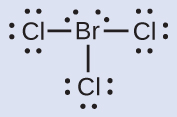
- Assign the solitary pairs to their atom. Now each Cl atom has seven electrons and the Br atom has seven electrons.
- Subtract this number from the number of valence electrons for the neutral cantlet. This gives the formal charge:Br: vii – 7 = 0Cl: 7 – vii = 0
All atoms in BrCliii have a formal accuse of zero, and the sum of the formal charges totals zero, equally it must in a neutral molecule.
Bank check Your Learning
Determine the formal charge for each atom in NCl3.
Answer:
N: 0; all three Cl atoms: 0

Using Formal Charge to Predict Molecular Structure
The organization of atoms in a molecule or ion is called its molecular construction. In many cases, following the steps for writing Lewis structures may lead to more than than one possible molecular structure—different multiple bond and lone-pair electron placements or dissimilar arrangements of atoms, for case. A few guidelines involving formal accuse tin can be helpful in deciding which of the possible structures is virtually likely for a particular molecule or ion:
- A molecular construction in which all formal charges are zilch is preferable to ane in which some formal charges are not zippo.
- If the Lewis structure must have nonzero formal charges, the organisation with the smallest nonzero formal charges is preferable.
- Lewis structures are preferable when adjacent formal charges are cipher or of the contrary sign.
- When nosotros must choose among several Lewis structures with similar distributions of formal charges, the structure with the negative formal charges on the more electronegative atoms is preferable.
To see how these guidelines apply, let us consider some possible structures for carbon dioxide, CO2. Nosotros know from our previous give-and-take that the less electronegative cantlet typically occupies the central position, only formal charges permit us to sympathize why this occurs. Nosotros can draw iii possibilities for the construction: carbon in the center and double bonds, carbon in the center with a unmarried and triple bail, and oxygen in the center with double bonds:

Comparing the iii formal charges, we can definitively place the construction on the left every bit preferable considering it has merely formal charges of zero (Guideline 1).
Equally another instance, the thiocyanate ion, an ion formed from a carbon atom, a nitrogen atom, and a sulfur atom, could have iii different molecular structures: CNS–, NCS–, or CSN–. The formal charges present in each of these molecular structures can assist us pick the about likely organisation of atoms. Possible Lewis structures and the formal charges for each of the 3 possible structures for the thiocyanate ion are shown hither:

Note that the sum of the formal charges in each case is equal to the accuse of the ion (–1). However, the get-go arrangement of atoms is preferred because it has the lowest number of atoms with nonzero formal charges (Guideline two). Too, it places the to the lowest degree electronegative cantlet in the eye, and the negative charge on the more than electronegative element (Guideline 4).
Example 3
Using Formal Charge to Determine Molecular Structure
Nitrous oxide, NtwoO, ordinarily known as laughing gas, is used as an anesthetic in minor surgeries, such every bit the routine extraction of wisdom teeth. Which is the probable structure for nitrous oxide?

Solution
Determining formal accuse yields the post-obit:

The structure with a terminal oxygen atom best satisfies the criteria for the most stable distribution of formal charge:

The number of atoms with formal charges are minimized (Guideline 2), and there is no formal charge larger than one (Guideline 2). This is once again consistent with the preference for having the less electronegative cantlet in the central position.
Check Your Learning
Which is the about likely molecular structure for the nitrite (NO2 −) ion?

Resonance
You may have noticed that the nitrite anion in Example 3 can have ii possible structures with the atoms in the aforementioned positions. The electrons involved in the Northward–O double bail, however, are in unlike positions:

If nitrite ions do indeed contain a single and a double bond, we would expect for the two bond lengths to be different. A double bond between ii atoms is shorter (and stronger) than a unmarried bond between the same two atoms. Experiments show, still, that both N–O bonds in NOtwo − accept the same strength and length, and are identical in all other properties.
It is not possible to write a single Lewis construction for NO2 − in which nitrogen has an octet and both bonds are equivalent. Instead, nosotros use the concept of resonance: if 2 or more Lewis structures with the same arrangement of atoms can be written for a molecule or ion, the actual distribution of electrons is an average of that shown by the various Lewis structures. The actual distribution of electrons in each of the nitrogen-oxygen bonds in NO2 − is the average of a double bond and a single bond. We call the individual Lewis structures resonance forms. The actual electronic structure of the molecule (the boilerplate of the resonance forms) is called a resonance hybrid of the individual resonance forms. A double-headed arrow between Lewis structures indicates that they are resonance forms. Thus, the electronic structure of the NO2 − ion is shown as:

We should retrieve that a molecule described as a resonance hybrid never possesses an electronic structure described by either resonance course. It does not fluctuate between resonance forms; rather, the actual electronic construction is ever the average of that shown past all resonance forms. George Wheland, one of the pioneers of resonance theory, used a historical analogy to draw the human relationship betwixt resonance forms and resonance hybrids. A medieval traveler, having never before seen a rhinoceros, described information technology every bit a hybrid of a dragon and a unicorn because it had many properties in mutual with both. Just as a rhino is neither a dragon sometimes nor a unicorn at other times, a resonance hybrid is neither of its resonance forms at any given fourth dimension. Similar a rhinoceros, information technology is a real entity that experimental evidence has shown to exist. It has some characteristics in mutual with its resonance forms, but the resonance forms themselves are convenient, imaginary images (like the unicorn and the dragon).
The carbonate anion, CO3 2−, provides a 2nd case of resonance:

One oxygen atom must accept a double bond to carbon to complete the octet on the fundamental atom. All oxygen atoms, however, are equivalent, and the double bond could form from any i of the iii atoms. This gives ascent to 3 resonance forms of the carbonate ion. Because we tin can write three identical resonance structures, we know that the actual arrangement of electrons in the carbonate ion is the average of the three structures. Once more, experiments prove that all iii C–O bonds are exactly the aforementioned.

The online Lewis Construction Make includes many examples to practice cartoon resonance structures.
Key Concepts and Summary
In a Lewis structure, formal charges can be assigned to each cantlet by treating each bond as if one-half of the electrons are assigned to each atom. These hypothetical formal charges are a guide to determining the nearly advisable Lewis structure. A structure in which the formal charges are every bit close to zero every bit possible is preferred. Resonance occurs in cases where 2 or more Lewis structures with identical arrangements of atoms but different distributions of electrons can be written. The bodily distribution of electrons (the resonance hybrid) is an average of the distribution indicated by the individual Lewis structures (the resonance forms).
Primal Equations
- [latex]\text{formal charge} = \# \;\text{valence beat electrons (free atom)} \; - \;\# \;\text{lonely pair electrons}\; - \frac{1}{two} \# \;\text{bonding electrons}[/latex]
Chemistry End of Affiliate Exercises
- Write resonance forms that depict the distribution of electrons in each of these molecules or ions.
(a) selenium dioxide, OSeO
(b) nitrate ion, NO3 −
(c) nitric acid, HNOiii (North is bonded to an OH group and two O atoms)
(d) benzene, C6H6:
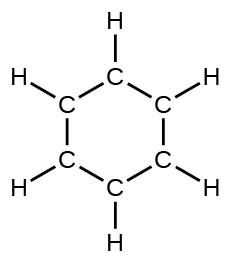
(east) the formate ion:
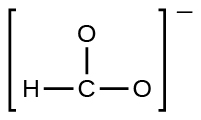
- Write resonance forms that describe the distribution of electrons in each of these molecules or ions.
(a) sulfur dioxide, SO2
(b) carbonate ion, CO3 2−
(c) hydrogen carbonate ion, HCO3 − (C is bonded to an OH group and two O atoms)
(d) pyridine:
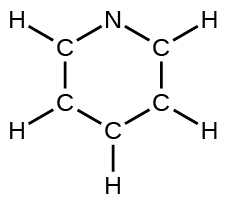
(e) the allyl ion:
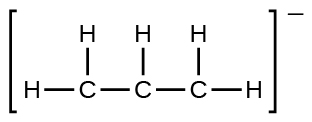
- Write the resonance forms of ozone, O3, the component of the upper atmosphere that protects the Earth from ultraviolet radiations.
- Sodium nitrite, which has been used to preserve salary and other meats, is an ionic compound. Write the resonance forms of the nitrite ion, NO2 –.
- In terms of the bonds present, explain why acetic acid, CH3CO2H, contains two singled-out types of carbon-oxygen bonds, whereas the acetate ion, formed by loss of a hydrogen ion from acetic acid, only contains 1 blazon of carbon-oxygen bail. The skeleton structures of these species are shown:

- Write the Lewis structures for the following, and include resonance structures where appropriate. Indicate which has the strongest carbon-oxygen bond.
(a) COii
(b) CO
- Toothpastes containing sodium hydrogen carbonate (sodium bicarbonate) and hydrogen peroxide are widely used. Write Lewis structures for the hydrogen carbonate ion and hydrogen peroxide molecule, with resonance forms where appropriate.
- Determine the formal charge of each chemical element in the following:
(a) HCl
(b) CFiv
(c) PCliii
(d) PFfive
- Determine the formal charge of each element in the following:
(a) HthreeO+
(b) SOfour 2−
(c) NH3
(d) O2 2−
(e) H2O2
- Calculate the formal accuse of chlorine in the molecules Cl2, BeCl2, and ClF5.
- Calculate the formal charge of each element in the following compounds and ions:
(a) F2CO
(b) NO–
(c) BFfour −
(d) SnCl3 −
(e) H2CCH2
(f) ClFiii
(1000) SeF6
(h) PO4 3−
- Draw all possible resonance structures for each of these compounds. Determine the formal accuse on each cantlet in each of the resonance structures:
(a) O3
(b) SO2
(c) NO2 −
(d) NO3 −
- Based on formal charge considerations, which of the following would likely exist the right organization of atoms in nitrosyl chloride: ClNO or ClON?
- Based on formal charge considerations, which of the following would likely be the correct arrangement of atoms in hypochlorous acid: HOCl or OClH?
- Based on formal charge considerations, which of the following would likely be the correct arrangement of atoms in sulfur dioxide: OSO or SOO?
- Draw the construction of hydroxylamine, HthreeNO, and assign formal charges; look upwardly the structure. Is the actual structure consequent with the formal charges?
- Iodine forms a series of fluorides (listed here). Write Lewis structures for each of the 4 compounds and determine the formal charge of the iodine cantlet in each molecule:
(a) IF
(b) IF3
(c) IFfive
(d) IF7
- Write the Lewis structure and chemic formula of the chemical compound with a molar mass of about lxx g/mol that contains nineteen.7% nitrogen and eighty.3% fluorine by mass, and determine the formal charge of the atoms in this compound.
- Which of the following structures would we expect for nitrous acid? Determine the formal charges:

- Sulfuric acid is the industrial chemical produced in greatest quantity worldwide. Near ninety billion pounds are produced each year in the United states of america solitary. Write the Lewis structure for sulfuric acrid, H2And then4, which has two oxygen atoms and two OH groups bonded to the sulfur.
Glossary
- formal accuse
- charge that would result on an cantlet by taking the number of valence electrons on the neutral atom and subtracting the nonbonding electrons and the number of bonds (one-one-half of the bonding electrons)
- molecular structure
- organisation of atoms in a molecule or ion
- resonance
- state of affairs in which one Lewis construction is insufficient to describe the bonding in a molecule and the average of multiple structures is observed
- resonance forms
- two or more Lewis structures that have the same arrangement of atoms but unlike arrangements of electrons
- resonance hybrid
- average of the resonance forms shown by the individual Lewis structures
Solutions
Answers to Chemistry End of Chapter Exercises
2. (a)

(b)

(c)

(d)
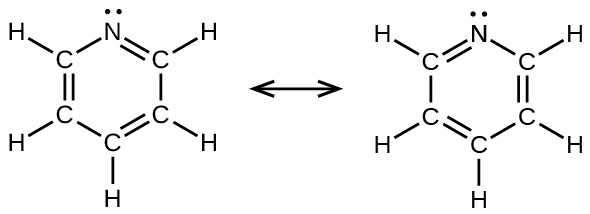
(due east)

4.

6. (a)

(b)

CO has the strongest carbon-oxygen bail because there is a triple bond joining C and O. CO2 has double bonds.
8. (a) H: 0, Cl: 0; (b) C: 0, F: 0; (c) P: 0, Cl 0; (d) P: 0, F: 0
10. Cl in Cl2: 0; Cl in BeCltwo: 0; Cl in ClFfive: 0
12. (a)
 ;
;
(b)
 ;
;
(c)
 ;
;
(d)

14. HOCl
16. The structure that gives nothing formal charges is consistent with the bodily construction:
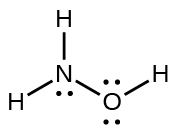
18. NF3;
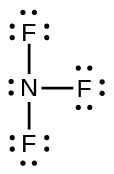
twenty.
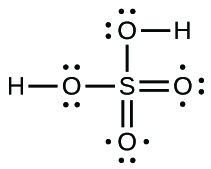
Source: https://opentextbc.ca/chemistry/chapter/7-4-formal-charges-and-resonance/
Posted by: levineingle1968.blogspot.com


0 Response to "Which Of The Following Species Is Best Described By Drawing Resonance Structures?"
Post a Comment